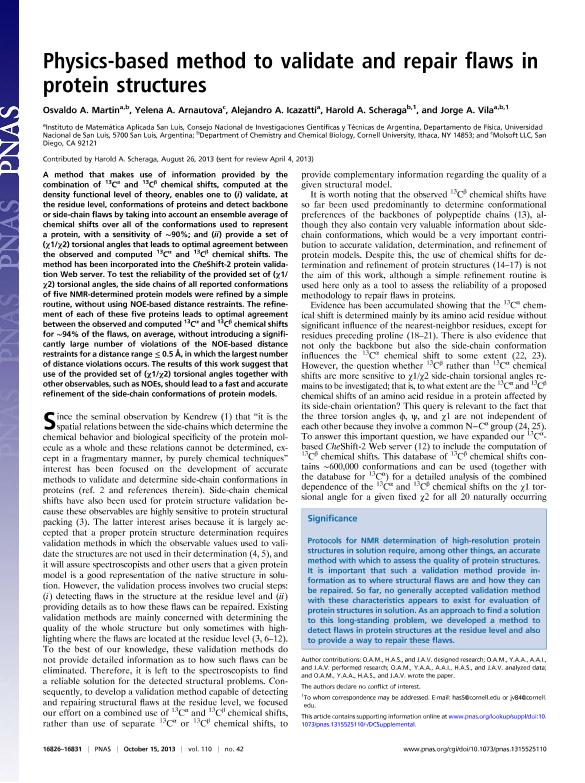Mostrar el registro sencillo del ítem
dc.contributor.author
Martín, Osvaldo Antonio

dc.contributor.author
Arnautova, Yelena A.
dc.contributor.author
Icazatti Zuñiga, Alejandro Ariel
dc.contributor.author
Scheraga, Harold A.
dc.contributor.author
Vila, Jorge Alberto

dc.date.available
2016-05-24T15:33:36Z
dc.date.issued
2013-10
dc.identifier.citation
Martín, Osvaldo Antonio; Arnautova, Yelena A.; Icazatti Zuñiga, Alejandro Ariel; Scheraga, Harold A.; Vila, Jorge Alberto; Physics-based method to validate and repair flaws in protein structures; National Academy of Sciences; Proceedings of the National Academy of Sciences of The United States of America; 110; 42; 10-2013; 16826-16831
dc.identifier.issn
0027-8424
dc.identifier.uri
http://hdl.handle.net/11336/5809
dc.description.abstract
A method that makes use of information provided by the combination of 13Cα and 13Cβ chemical shifts, computed at the density functional level of theory, enables one to (i) validate, at the residue level, conformations of proteins and detect backbone or side-chain flaws by taking into account an ensemble average of chemical shifts over all of the conformations used to represent a protein, with a sensitivity of ∼90%; and (ii) provide a set of (χ1/χ2) torsional angles that leads to optimal agreement between the observed and computed 13Cα and 13Cβ chemical shifts. The method has been incorporated into the CheShift-2 protein validation Web server. To test the reliability of the provided set of (χ1/χ2) torsional angles, the side chains of all reported conformations of five NMR-determined protein models were refined by a simple routine, without using NOE-based distance restraints. The refinement of each of these five proteins leads to optimal agreement between the observed and computed 13Cα and 13Cβ chemical shifts for ∼94% of the flaws, on average, without introducing a significantly large number of violations of the NOE-based distance restraints for a distance range ≤ 0.5 Ǻ, in which the largest number of distance violations occurs. The results of this work suggest that use of the provided set of (χ1/χ2) torsional angles together with other observables, such as NOEs, should lead to a fast and accurate refinement of the side-chain conformations of protein models.
dc.format
application/pdf
dc.language.iso
eng
dc.publisher
National Academy of Sciences

dc.rights
info:eu-repo/semantics/openAccess
dc.rights.uri
https://creativecommons.org/licenses/by-nc-sa/2.5/ar/
dc.subject
Chemical Shifts
dc.subject
Proteins
dc.subject
Validation
dc.subject
Repair
dc.subject.classification
Física Atómica, Molecular y Química

dc.subject.classification
Ciencias Físicas

dc.subject.classification
CIENCIAS NATURALES Y EXACTAS

dc.title
Physics-based method to validate and repair flaws in protein structures
dc.type
info:eu-repo/semantics/article
dc.type
info:ar-repo/semantics/artículo
dc.type
info:eu-repo/semantics/publishedVersion
dc.date.updated
2016-05-16T20:08:12Z
dc.journal.volume
110
dc.journal.number
42
dc.journal.pagination
16826-16831
dc.journal.pais
Estados Unidos

dc.journal.ciudad
Washington
dc.description.fil
Fil: Martín, Osvaldo Antonio. Cornell University; Estados Unidos. Consejo Nacional de Investigaciones Científicas y Técnicas. Centro Científico Tecnológico San Luis. Instituto de Matemática Aplicada de San Luis; Argentina
dc.description.fil
Fil: Arnautova, Yelena A.. Molsoft LLC.; Estados Unidos
dc.description.fil
Fil: Icazatti Zuñiga, Alejandro Ariel. Consejo Nacional de Investigaciones Científicas y Técnicas. Centro Científico Tecnológico San Luis. Instituto de Matemática Aplicada de San Luis; Argentina
dc.description.fil
Fil: Scheraga, Harold A.. Cornell University; Estados Unidos
dc.description.fil
Fil: Vila, Jorge Alberto. Cornell University; Estados Unidos. Consejo Nacional de Investigaciones Científicas y Técnicas. Centro Científico Tecnológico San Luis. Instituto de Matemática Aplicada de San Luis; Argentina
dc.journal.title
Proceedings of the National Academy of Sciences of The United States of America

dc.relation.alternativeid
info:eu-repo/semantics/altIdentifier/url/http://www.pnas.org/content/110/42/16826.abstract
dc.relation.alternativeid
info:eu-repo/semantics/altIdentifier/doi/http://dx.doi.org/10.1073/pnas.1315525110
dc.relation.alternativeid
info:eu-repo/semantics/altIdentifier/doi/10.1073/pnas.1315525110
Archivos asociados
